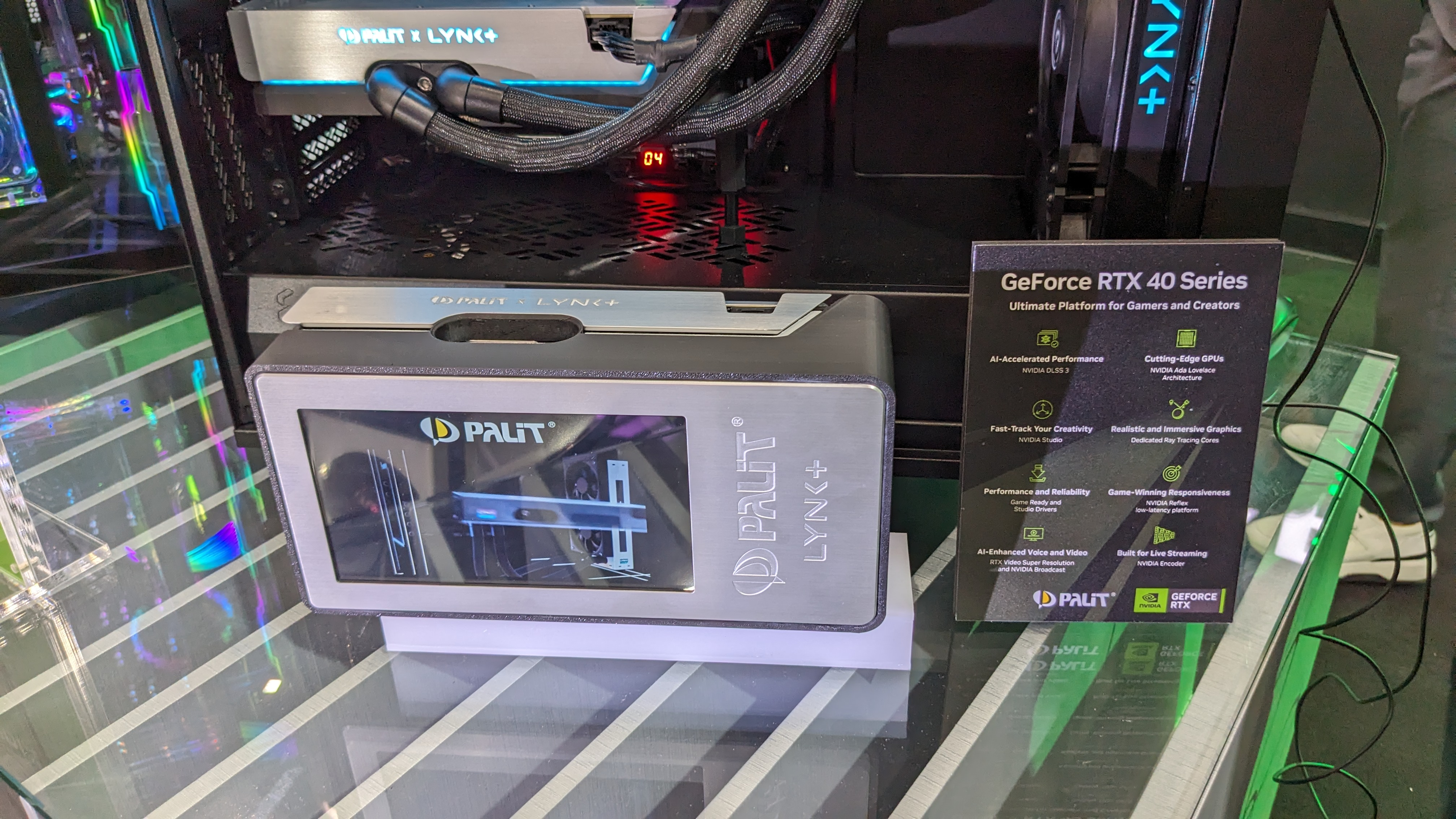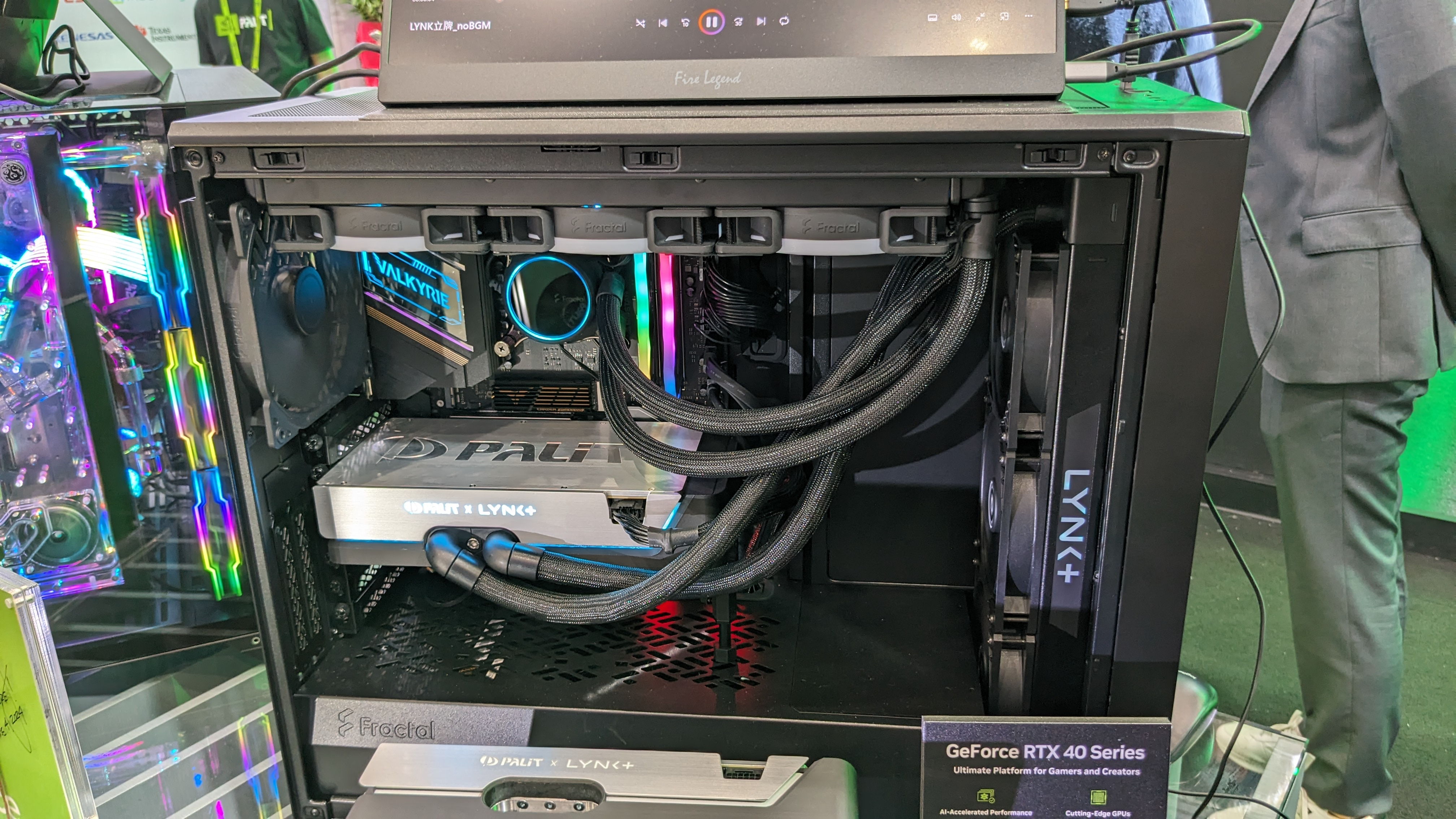This overpowered RTX 4090 card has a built-in water block, a screen and a modular AIO
The water pump pops right onto the GPU and you screw on the tubes.

Open-loop cooling provides some of the best results, particularly when you have the right water block to put on your graphics card. However, when you have to start putting in your own coolant, cutting the tubes, and filling a reservoir, it's an expensive hassle and risky should your coolant leak onto your components.
Lynk+, a German startup, has a solution. Why not build the ultimate water block into your graphics card and then sell AIO coolers that can attach to it? At Computex 2024, Lynk+ and GPU maker Palit teamed up to make a prototype RTX 4090 card with an aluminum water block that connects to one of Lynk+'s modular AIOs.
Unlike ordinary AIO coolers, Lynk+'s doesn't come with the tubes already connected to the block. You take a plastic piece called the quick connector and put it in a crevice in the graphics card's water block, using one screw to secure it. Then the tubes themselves screw onto the quick connector. The pump itself is located on the radiator.
Because you're never putting coolant into the tubes or touching the coolant, there's no risk of leaks. Theoretically, you could use one AIO to cool your CPU and GPU. Or you could daisy chain multiple radiators with multiple water blocks for a system that had more than one GPU.
When we visited Palit's Computex 2024 booth, two different prototypes were on display. The one that was sitting on a table had a 7-inch color screen on the top of its water block. So, not only would the GPU stay cool, but it would also be able to show you stats about the graphics card's performance or your fps in a game.
The other prototype, which was inside a desktop, was the same except that it didn't have the screen on it. To be fair, many enthusiasts don't need a screen in their cases; they just want excellent cooling.

A Lynk+ representative told us that the aluminum water block has a built-in, patented vapor chamber that allows it to cool even better than most open-loop systems. He claimed that he was able to run the graphics card pulling a 500W load, which is about 50W above average, while keeping the temperature to just 60 degrees C. He said he hadn't tried overclocking the card, but with that kind of thermal headroom, the GPU maker or the user could really boost clock speeds.
Get Tom's Hardware's best news and in-depth reviews, straight to your inbox.
In a YouTube video that was filmed before Computex, Overclocker and Cooling Expert der8auer tested the Palit + Lynk+ GPU. After 15 minutes of gaming, his RTX 4090 consumed 390 watts, but it was only 58.2 degrees C.
Currently, Lynk+ and Palit only have a prototype graphics card, but it sounds like this sound will soon become a real product. We have no idea what it could cost, but if it gives you epic performance without the need to handle coolant, it could be worth every penny.
Avram Piltch is Managing Editor: Special Projects. When he's not playing with the latest gadgets at work or putting on VR helmets at trade shows, you'll find him rooting his phone, taking apart his PC, or coding plugins. With his technical knowledge and passion for testing, Avram developed many real-world benchmarks, including our laptop battery test.
- Jowi MoralesContributing Writer
-
thestryker I'm still hopeful that Lynk+ can get some OEMs onboard as it seems like an ideal way to do liquid cooling, for graphics especially. It's got the benefit of custom in that you could just swap out the card without replacing everything and the benefit of an AIO in not worrying about setup and scheduled maintenance.Reply
If I'm remembering right from last year the way they've designed the coolers doesn't cost more than a video card air cooler. So outside initial cost of buying the pump/rad combo cards themselves wouldn't have to carry a premium. -
CmdrShepard ReplyThe one that was sitting on a table had a 7-inch color screen on the top of its water block. So, not only would the GPU stay cool, but it would also be able to show you stats about the graphics card's performance or your fps in a game.
So let me get this straight, the display is there so I can watch stats or FPS while I am playing a game?
Is this a product for Batarians by any chance? -
watzupken My question is who will buy a costly flagship card released 1.5 years ago, when the expectation is that the next gen is about 6 months away? So other than bragging rights by the company, I don't see people paying this much for some exotic cooling solution and extra screen.Reply -
evdjj3j When I saw this headline yesterday my brain saw overpriced instead of overpowered. Ha ha.Reply


